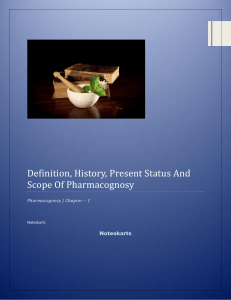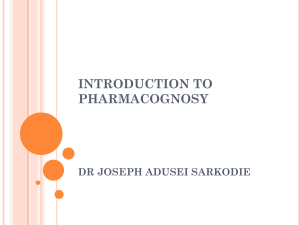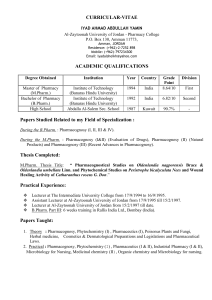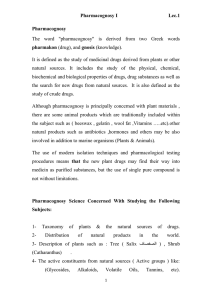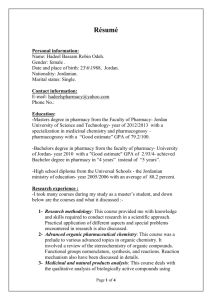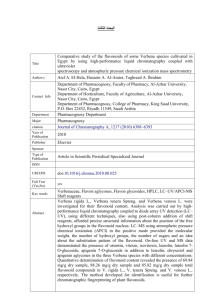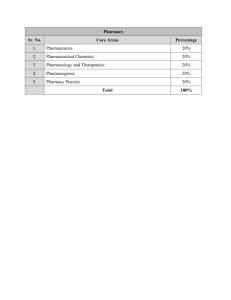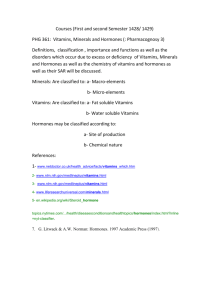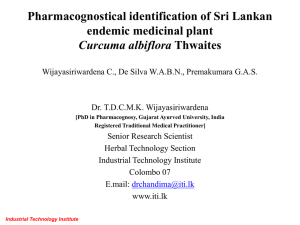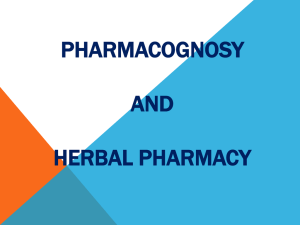Lecture 1
advertisement
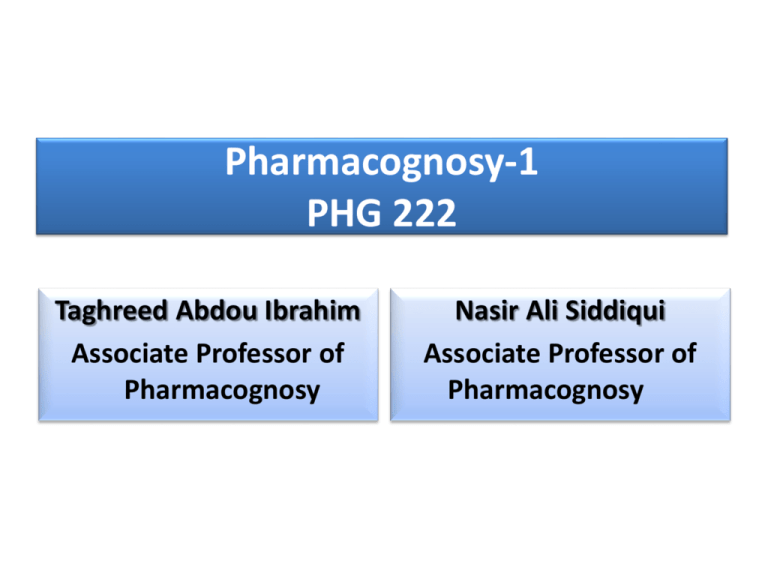
Pharmacognosy-1 PHG 222 Taghreed Abdou Ibrahim Associate Professor of Pharmacognosy Nasir Ali Siddiqui Associate Professor of Pharmacognosy Topics of the Course Topic Introduction to Pharmacognosy No. of hours 2 Medicinal plants in selected health care systems 4 Production and Preparation of crude drugs 4 Plant metabolites & biosynthetic pathway 2 Medicinal plants (botanical and chemical characters) 9 Basic Principles and Application of Chromatography 7 Introduction to Pharmacognosy Lecture 1 Learning outcomes of the lecture By the end of the lecture, the students should be able to: 1- Define terms related to pharmacognosy and natural products. 2- Recognize the history of natural products. What is Pharmacognosy The word Pharmacognosy is derived from the Greek "Pharmakon", meaning a drug or poison. and, “Gignosko" meaning to acquire a knowledge of, and literally meaning "the entire knowledge of drug". Pharmacognosy, is an applied science that deals with the biological, biochemical and economic features of natural crude drugs and their constituents. It is a study of drugs from plant, animal and mineral sources and their natural constituents. e.g.: Digitalis leaf & its glycosides (digitoxin) Thyroid gland & its extracted hormone (thyroxin) Kaolin and Talc powder Pharmacognosy • The scientific study of the structural, physical, chemical and sensory characters of crude drugs of vegetable, animal and mineral origin. • It also includes their history, cultivation of the medicinal plants producing them and methods involved for their collection and other particulars related to the treatment they received during their passage from the producer to the distributor or pharmacist and Storage. Recently Pharmacognosy includes: 1- Modern isolation techniques. 2-Pharmacological testing procedures to prepare purified substances. 3- Cultivation and propagation by tissue culture. 4- Marine Pharmacognosy. What Do Pharmacognosists “Do”? 1- Extraction of selected plant material. 2- Isolation & characterization of “active constituents”. 3- Characterization of the pharmacology of crude extracts & active constituents. 4- Evaluation of quality of natural medicines. 5- Interdisciplinary relationship with ethnobotany & ethnopharmacology. Definitions Ethnobotany is the study of the relationship between people and plants, field includes studying plants as medicines, alternative methods for healing, as wild foods, as agricultural crops; modes of transportation; as clothing and in the religious ceremonies. Ethnopharmacology is the scientific study correlating ethnic groups, their health, and how it relates to their physical habits and methodology in creating and using medicines. Ethnomedicine: It refers to the use of local plants as medicine by the population surrounding the vegetation. Traditional medicine: It is the sum total of all non-mainstream medical practices, usually excluding so called “western” medicine. History of Pharmacognosy 1- Ancient Egyptian period • The ancient Egyptians 3000 B.C. were experts in using drugs for curing diseases. • The healing of the sick was undertaken by priest doctor and pharmacist "Son" who prescribed and prepared medicines. • Crude drugs of vegetable origin used included Aloes, Gum, Myrrh, Poppy, Pomegranate, Colocynth, Linseed, Squill, Coriander, Onion, Anise, Melon, Castor, etc... The first recorded prescriptions were found in Egyptian tombs. These were the Hieratic papyri, Ebers papyrus, the Gynecologic papyrus. 2- The Babylonians Period 2- The Babylonians Period • The Babylonian medicine was known (Laws of Hamorabi 772 B.C.). • The drugs used were mainly of vegetable origin. • The drugs used include 250 materials of plant, and 180 materials of animal source. Many of these drugs were known to the ancient Egyptians. 3- Old Indian Medicine 3- Old Indian Medicine • The "Riveda" and Ayurveda (Acoko 2000 B.C.), contained the sacred medicinal plants. • The collection of plant materials was done only by an innocent, pure, religious person. • The fresh plants were considered to be the most effective. • The most celebrated Indian drugs were; Sandal wood, Clove, Pepper, Cardamom, Caraway, Ginger, Benzoin, Cannabis, Castor oil, Sesame oil, Aloes, etc... 4- The old Chinese Medicine 4- The old Chinese Medicine • Beside the famous acupuncture, the Chinese medicine is very acknowledged for the herbal medicine. • The Pen Ts'ao Kang Moa 1000 B.C. contained an incredible number of medicinal plants and drugs of animal origin. • Their book includes many recipes for every disease. Among the plants and minerals highly esteemed for its magic health including power were; Ginseng, Rhubarb, Ephedra, Star Anise, Pomegranate, Aconite.... Opium is a very old Chinese drug for diarrhea and dysentery. 5- The Greek and Romans a- Authors of antiquity Hippocrates (460-377 BC) “The Father of Medicine”, was familiar with numerous drugs, and wrote "Corpus Hipocraticum 460 B.C.". b- The Greek Empire was followed by that of the Romans Dioscorides who was a Greek by birth he was the first to describe drugs and his work "Greek Herbal of Dioscorides" included 5000 medicinal plants in addition to animal and mineral drugs. c- Pliny who lived about the same time as Dioscorides, was also an eminent author of natural history. d- Galen (134- 200 A.C.) was a physician and to him is ascribed the use of "Galenical preparations". 6- Islamic Contributions • In Islamic writings were found the first beginnings of chemistry, the name of which is derived from an Arabic word "Kemia"; as were also such familiar words alcohol and alkali. • The Arabs added numerous new plants and medicaments to those already known to the Greeks and Romans. • In their days, pharmacy attained its highest reputation and became an independent branch of medicine. • It is interesting to note that the first dispensary was opened in Baghdad, the center of trade in those days. • The dispensary was made of Sandal wood and named "Sandalia". • Rhazey (850-932 A.C.) who was born at Rai in Persia was the director of Baghdad hospital in the days of ElMansour. • He published a famous book "Alhawi Kabeer". • Abu Al Hosayn Ibn-Sina (980-1037 A.C.) whose name was latinised to Avicenna. He was one of the most eminent and gifted Arabian physicians. • His "Canoon Fi Elteb" has been described as the most famous medical text ever written and as having dominated the medical schools of Europe and Asia and served as the chief source of medical knowledge for 5 centuries, till the 15th century. Ibn Al-Baitar (1197-1248 A.C.) was the best Arabian pharmacognosist and botanist and ranked with Dioscorides in that respect. His book "Jame-ul-Muffradat" contains description of 2000 drugs. • Sheikh Dawood El-Antaki wrote a book named "Tazkaret Uli Al-Albab", now known as "Tazkaret Dawood Alantaki" which describes several hundred herbs besides drugs of animal and mineral origin. The 18th Century, Pharmacognosy • Johann Adam Schmidt (1759-1809): In 1811 his Lehrbuch der Materia Medica was published, which was a work on medicinal plants and their properties. In this book the term "pharmacognosy" is originally coined. • Carle Linnaeus (naming and classifying plants). • At the end of the 18th century, crude drugs were still being used as powders, simple extracts, or tinctures. The Era of Pure Compounds (In 1803, a new era in the history of medicine) • Isolation of morphine from opium • Strychnine (1817) from nux vomica seeds. • Quinine and caffeine (1820) from cinchona bark and coffee beans, respectively. • Nicotine (1828) from tobacco leaves. • Atropine (1833) from belladonna leaves. • Cocaine (1855) from coca leaves. • In the 19th century, the chemical structures of many of the isolated compounds were determined • In the 20th century, the discovery of important drugs from the animal kingdom, particularly hormones and vitamins. Microorganisms have become a very important source of drugs
